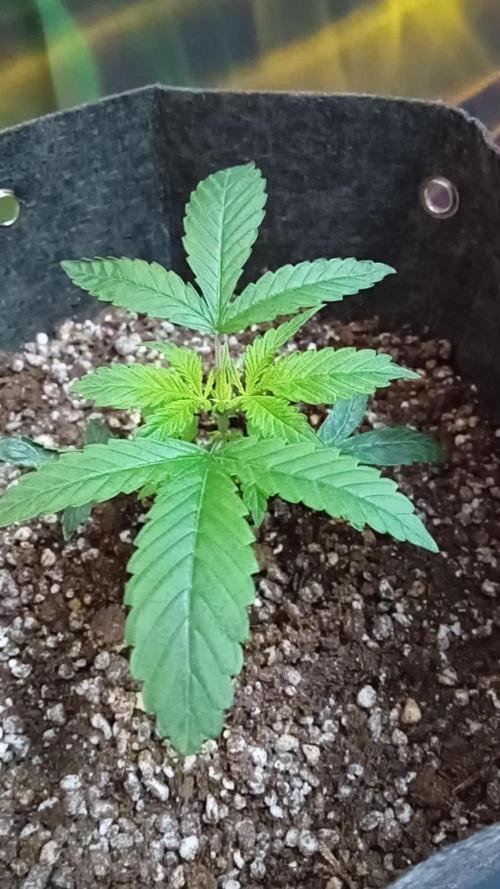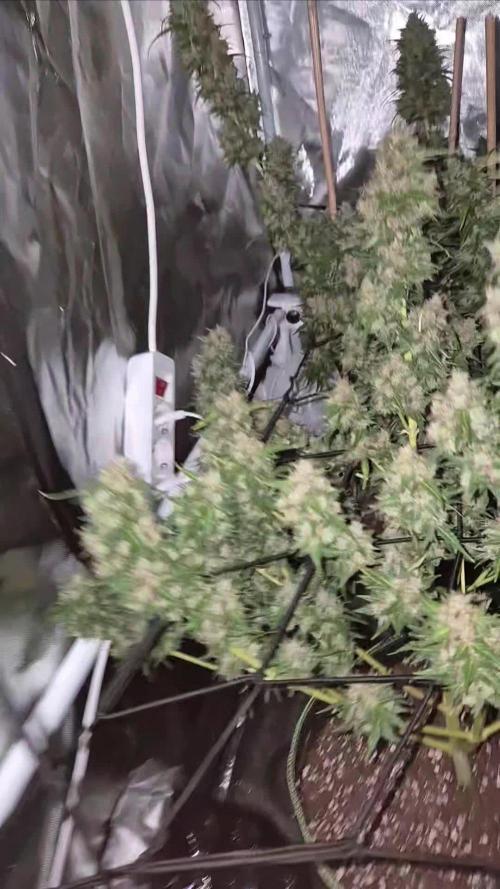The Grow Awards 2026 🏆 































Likes
Comments
Share


@MrGoonai
Follow
10/17/24 Short facts:
- Continued with LST
- Watered: 1 x 1.2L, 1 x 0.3L
- VPD @ 0.9 — raised by 0.1
- Light @ 50% ~580 - 620 PPFD
- Removed 5 leaves
---------------------------------------------------------------------------------
As promised last week, i made a video and explained the progress so far, and did show you the plant.
Not much to report. I continued LST, though I’ve stopped for a few days now since the branches are well spread out, and that should be enough for the time being.
The AvT was in Preflower since last week and switched to flower on day 28.
Really good plant. No problems at all.
Likes
2
Share


@MaltaHerbman
Follow
Day 21 of the Auto Fractal on this plant will not do topping as she stayed a bit short for now but will do LST.This week will add more the ppm as soon they start flowering.
Processing
Likes
1
Share


@growbuntu
Follow
Noticed some spots on the leafs I think it's due to the heat (discoloring mostly, not related to a nute burn)
Likes
27
Share


@w33dhawk
Follow
Moin alle zusammen diese Woche war wieder nicht viel los.
23.03.23 Giessen 3L Wasser und 0,5L Compost Tee danach eine leichte entlaubung um den Luftstrom zu erhöhen und etwas mehr Licht in das Blätterdach zu bekommen.
24-26.03.23 chillen und genießen 😋
27.03.23 Giessen nur Wasser (ab gestanden ohne Ph Anpassung) 3,5L
28-29.03.23 chillen und genießen😇
Edid: zum Geruch der Moschus Ton ist weg daraus ist in dieser Woche eine zarte Karamell Note geworden die die Haupt note ananas küsst wirklich eine sehr leckere Geruchs combination zudem wird der Geruch von Tag zu Tag intensiver und es mischt sich der typische Gras Geruch drunter aber nicht zu aufdringlich!
Das wars für diese Woche ihr growmies!
Likes
4
Share


@Bncgrower
Follow
Another week almost over, the girls are beautiful and smell great. Apparently everything is under control, I'm really looking forward to the results.
Happy growing! 🌱🌱🌱
Likes
14
Share


@DTHEREID
Follow
Wow! Hard to believe these are autoflowers, I’ve never harvested a cola off an autoflower quite this robust.
The hps lights in the 2nd grow room were maybe a bit much and all the plants handled it differently.
The big beast is one that did very nicely under the hps lights.
The smaller much more frostier dried bud is from the mars hydro ts1000 grow tent. Not nearly the yield or density but beautiful crystal covering the buds. Amazing colour from both the led grow dark devils and the hps ones.
Likes
Comments
Share


@mihixd
Follow
Plants are looking good! I harvested the 2 plants on the left on D82. Drying them in a 4x2 rn, the 2 remaining plants will stay in flower tent until the drying tent clears up. They could use an extra 10 days for a little more size :). Very strong smell! my carbon filter was struggling haha.
D78
10L
D81
8L
D82
2 harvested
Likes
4
Share


@eldruida_lamota
Follow
Vamos familia, actualizamos la cuarta semana de floración de estas Thunder Banana de Seedstockers, salieron las 3 de 3, 100% ratio éxito.
Aplicamos varios productos de Agrobeta, que son increíbles para aportar una buena alimentación a las plantas.
Temperatura y humedad dentro de los rangos correctos dentro de la etapa de floración.
La tierra utilizada es al mix top crop, por cambiar.
De 3 ejemplares seleccioné los 2 mejores para completar el indoor, cambié el fotoperiodo a 12/12 y también apliqué una poda de bajos, se ven bien sanas las plantas, tienen un buen color progresan a muy buen ritmo por el momento, las flores están tricomando que da miedo.
Agrobeta:
https://www.agrobeta.com/agrobetatiendaonline/36-abonos-canamo
Hasta aquí todo, Buenos humos 💨💨💨.
Likes
113
Share


@PEAKYPLANTERS
Follow
my northern lights seem to fly .... i am amazed by their structure ...
I'm starting to use some of the techniques I learned from you ... I hope everything will be fine and above all I hope to pull out some nice bombs ...
I also bought a ph reducer and a good GHE tester ... because for my girls I want only the best ..
a greeting to all the friends who follow me ...
happy and abundant crops
Likes
207
Share


@DogDoctorOfficial
Follow
Week 2 flowering up we go 😆💚🙏 so far so good , loving everything 🙌🙌🙌🙏🙏🙏💚💚💚
Im slowly training them to better fell my canopy, loving the stretching and the node distance on this beauty’s 💚💚💚✊✊✊🙏🙏🙏🙌🙌🙌
Have been 9 days since i flip this girls to 12/12 and to my eyes they wore in need of some defoliation, I wasn’t going to go hard on them but as always I ended up going as far as i though needed for a correct airflow, and also to select with branches stay with ones go.😆 i know they look unhappy af after hard defoliations , but tomorrow they are happy again and in a couple of days it will look like there was no defoliation at all 😅
Reduced my lights to 80% and gave them water with a PH 6.2 @ 260 Ppms, in it i had regulator, calmag, P, Top and start booster. Not using any NPK in liquid form, im using AptusHolland All in One Palettes with i have had had to the soil in the beginning of the grown .
Not gona lie the limonene and the beta-pinene terpenes jumping all over like crazy wile defoliation 💚🙌 i believe they will be smelly girls 😆😅💚🙏🙏🙏
Hope you all had an amazing 2021 and that 2020Too brings you all loads of love and health, growers love to you all, thank for stoping by and read my diaries, means a lot to me 🙏🙏🙏💚💚💚🙌🙌🙌 happy new year you all 💚💚💚
And with enormous honor and pleasure that i start collaborating with Zamnezia and Viparspectra
For this run i will have the pleasure of growing some Runtz genetics from Zamnezia seeds that they wore kind enough to send me for test and review 🙏🙏🙏💚💚💚🙏🙏🙏 and for the testing and reviewing i was blessed with the VIPARSPECTRA model P2000💚💚💚🙏🙏🙏 they wore amazing and send me this LED light for me to do some testing and some reviews. Special thanks to Zamnezia and to Viparspectra for this opportunity, lets make magic together 💚💚💚🙏🙏🙏
All i grow is medicine for myself, for me and for my best friend with is me 😆 nothing to sell, so don’t even ask 😅💚💚💚
All info and full product details can be find in can find @
https://viparspectra.eu/collections/grow-lights DISCOUNT CODE 5% - DOGDOCTOR ( all store )
https://www.zamnesia.com DISCOUNT CODE 10% - GROWITGD ( just for seeds )
https://aptus-holland.com/
More info and updates @
https://growdiaries.com/grower/dogdoctor
https://instagram.com/dogdoctorofficial
https://youtube.com/channel/UCR7ta4DKLFMg2xxTMr2cpIg
💚💚💚Growers love to you all 💚💚💚
Likes
4
Share


@Facocero
Follow
È iniziata da poco la 4°settima, sembra stiano crescendo bene le piccole😍 in questi giorni mi sono dedicato a un po' di defogliazione e di giorno in giorno cerco di migliorare LST per favorire la penetrazione della luce.
Alzato il dimmer al 75% e ho allontanato un po' la lampada dalle piante e sembra stia o reagendo bene! Spero tanto di fare un buon lavoro! 💪 Ai prossimi aggiornamenti!
AGGIORNAMENTO: Sono passati 2 giorni dalle ultime foto pubblicate, si stanno infoltendo per bene le piccole😍 aspetterò ancora un altro po' per mandarle in fioritura,vorrei riuscire ad occupare più spazio superficiale possibile.
Sto alternando con le annaffiature fertilizzando moderatamente una volta si e una no.. per il momento sembra tutto ok!😎
Likes
168
Share


@Tropicannibis_Todd
Follow
💩Holy Crap Growmies , we are outdoors and in the Ground and there Doing Great💩
👉It's been another full week and she's in full on flowerin mode ,🤔 👈
Out of all the girls in the garden she's been the tuffest , I've had zero issue with her 👈
I GOT MULTIPLE DIARIES ON THE GO 😱 please check them out 😎
👉THANKS FOR TAKING THE TIME TO GO OVER MY DIARIES 👈
👉NutriNPK NUTRIENTS USED FOR FEEDING 👈rain water to be used entire growth👈
Likes
16
Share


@bro8006
Follow
Hey y'all whtas up..
Did some have defo Last week but hinestly seems like The SS keep regroing lol só bad.
Niw i will wait 2 mores weeks tô defoliate once again.
The nuts are correct and as we started week 3 both are getting and will keep on nirvana for 3 more weeks.
On The back are the 2 RD. FOR FOR ABOT CHECK MY OTHER vídeo..
Thank later will post picture fri m2day.. I jus have been quite busy no enought time tô prepare..
Cheers mates..
Likes
27
Share


@GODSGIFT_2005_JM
Follow
🥊
🍼Greenhouse Feeding BioGrow & Bio Enhancer
⛺️MARSHYDRO
The ⛺️ has a small door 🚪 on the sides which is useful for mid section groom room work. 🤩
☀️ MARSHYDRO FC 3000 LED 300W
☀️Also special thanks to VIPERSPECTRA P2000 (200W) & XS2000(240w) LED growlights
🌱 FASTBUDS 420
Likes
5
Share


@CannaIGrow
Follow
Still just trying to be patient, waiting for harvest time, hopefully I don't go past the harvest window that I'm looking for. Wanting Milky tricomes.
Likes
6
Share


@DrShotzUK
Follow
Banana purple punch - 420 fast buds
Looking so healthy now, early stages she almost didn’t make it but now she’s covered in purple buds , shining with thricomes , frosted all over and smells like berries and tropical sort of profile with gassy earthy notes also.
I am excited to smoke her in 3/4 weeks time
DRSHOTZUK
@420fastbuds






















